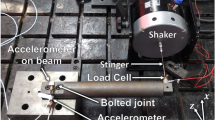Abstract
Bolted joints often have a significant effect on the dynamical behavior of assembled mechanical structures. An accurate model of an assembled structure depends on correctly determining and identifying the dynamic parameters of bolted joints. This paper presents an alternative method for identifying these dynamic parameters using structure’s natural frequency and damping. A novel experiment is designed with a test piece consisting of only bolted joints, with the governing equations of the test piece established using the analytical method. The relationships between the equivalent dynamic parameters of the bolted joints and the natural frequencies and damping ratios of the test piece are determined for both the normal and tangential directions. The parameter identification problem for bolted joints is thus transformed into a test of the natural frequency and the damping ratio of the test piece. In order to check the accuracy of the proposed identification method, the test piece and bolted joints are modeled using the finite element method (FEM) and the dynamic properties of the test piece are analyzed. The maximum error between the natural frequencies of the FEM result and the experimental values in the normal and tangential models are 4.73% and 0.34%, respectively. The result indicates that the proposed method is valid for the dynamic parameter identification of bolted joints.
Similar content being viewed by others
References
L. Gaul and R. Nitsche, The role of friction in mechanical joints, Applied Mechanics Reviews, 54(2) (2001) 93–106.
C. F. Beards, Damping in structural joints, The Shock and Vibration Digest, 24(7) (1992) 3–7.
E. E. Ungar, Status of engineering knowledge concerning damping of built-up structures, Journal of Sound and Vibration, 26(1) (1973) 141–154.
R. A. Ibrahim and C. L. Pettit, Uncertainties and dynamic problems of bolted joints and other fasteners, Journal of Sound and Vibration, 279(3–5) (2005) 857–936.
W. P. Fu, Y. M. Huang and X. L. Zhang, Experimental investigation of dynamic normal characteristics of machined joint surfaces. Journal of Vibration and Acoustics, 122 (2000) 393–398.
S. S. Park and J. Chae, Joint identification of modular tools using a novel receptance coupling method, Int J Adv Manuf Technol, 35 (2008) 1251–1262.
J. S. Tsai and Y. F. Chou, The identification of dynamic characteristics of a single bolt joint, Journal of Sound and Vibration, 125 (1988) 487–502.
H. Y. Hwang, Identification techniques of structure connection parameters using frequency response functions, Journal of Sound and Vibration, 212 (1998) 469–479.
J. Wang, P. Sas, A method for identifying parameters of mechanical joints, ASME Journal of Applied Mechanics, 57 (1990) 337–342.
F. Hu, B. Wu, Y. Hu and T. Shi, Identification of dynamic stiffness matrix of bearing joint region, Front. Mech. Eng. China, 4(3) (2009) 289–299.
J. H. Wang and S. C. Chuang, Reducing errors in the identification of structural joint parameters using error functions, Journal of Sound and Vibration, 273 (2004) 295–316.
Y. Ren and C. F. Beards, Identification of joint properties of a structure using FRF data, Journal of Sound and Vibration, 186 (1995) 567–587.
Y. Ren and C. F. Beards, Identification of ‘effective’ linear joints using coupling and joint identification techniques, ASME Journal of Vibration and Acoustics, 120 (1998) 331–338.
W. Liu and D. J. Ewins, Substructure synthesis via elastic media. Journal of Sound and Vibration, 257 (2002) 361–379.
S. Y. Lee, K. H. Ko and J. M. Lee, Analysis of dynamic characteristics of structural joints using stiffness influence coefficients. KSME International Journal, 14(12) (2000) 1319–27.
D. H. Lee and W. S. Hwang, An identification method for joint structural parameters using an FRF based substructuring method and an optimization technique, Journal of Mechanical Science and Technology, 21 (2007) 2011–2022.
T. Yang, H. S. Fan and S. C. Lin, Joint stiffness identification using FRF measurements, Computers and Structures 81 (2003) 2549–2556.
D. Čelič and M. Boltežar, Identification of the dynamic properties of joints using frequency — response functions, Journal of Sound and Vibration, 317 (2008) 158–174.
K. Mao, B. Li, J. Wu and X. Shao, Stiffness influential factors-based dynamic modeling and its parameter identification method of fixed joints in machine tools, International Journal of Machine Tools & Manufacture, 50 (2010) 156–164.
O. Özsahin, A. Ertürk, H. N. Özgüven and E. Budak, A closed-form approach for identification of dynamical contact parameters in spindle-holder-tool assemblies, International Journal of Machine Tools & Manufacture, 49 (2009) 25–35.
X. Ma and L. Bergman, A. Vakakis, Identification of bolted joints through laser vibrometry. Journal of Sound and Vibration, 246 (2001) 295–316.
H. Jalali, H. Ahmadian and J. E. Mottershead, Identification of nonlinear bolted lap-joint parameters by force-state mapping, International Journal of Solid and Structures, 44 (2007) 8087–8105.
H. Ahmadian and H. Jalali, Generic element formulation for modelling bolted lap joints, Mechanical Systems and Signal Processing, 21(5) (2007) 2318–334.
S. Candan and I. Elishakoff, Constructing the axial stiffness of longitudinally vibrating rod from fundamental mode shape, International Journal of Solids and Structures, 38 (2001) 3443–3452.
H. Antes, Fundamental solution and integral equations for Timoshenko beams, Computers and Structures, 81 (2003) 383–396.
C F Beards. The damping of structural vibration by controlled interfacial slip in joints, Journal of Vibration and Acoustics, Stress and Reliability in Design, 105(10) (1983) 369–373.
D. J. Ewins, Modal testing: theory and practice, Research Studies Press, New York, Wiley, 2000.
Author information
Authors and Affiliations
Corresponding author
Additional information
Recommended by Editor Yeon June Kang
Ling Li is a lecturer in the College of Coustruction Machinery, Chang’an University. He graduated from Beijing University of Technology with a Ph.D in Mechanical Engineering. His research interests include machine dynamics, mechanical behavior of the bolted joints and interfaces of the critical structures, non-linear mechanics, and accuracy design of machine tool, etc.
Rights and permissions
About this article
Cite this article
Guo, T., Li, L., Cai, L. et al. Alternative method for identification of the dynamic properties of bolted joints. J Mech Sci Technol 26, 3017–3027 (2012). https://doi.org/10.1007/s12206-012-0815-7
Received:
Revised:
Accepted:
Published:
Issue Date:
DOI: https://doi.org/10.1007/s12206-012-0815-7




